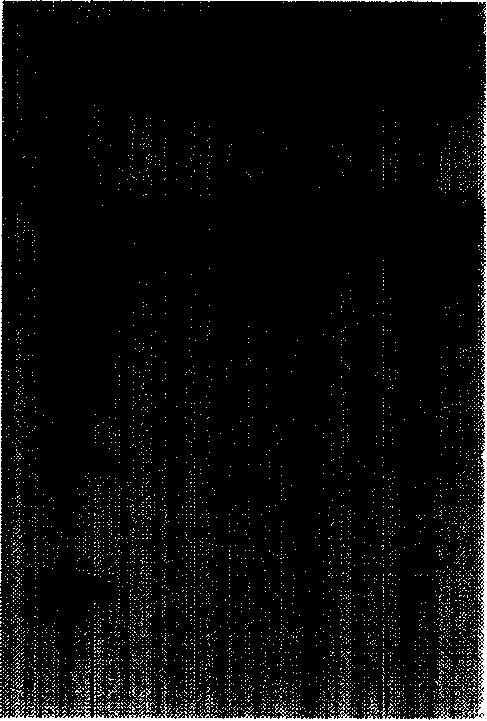Method for extracting bacteria plasmid DNA
A bacterial plasmid and bacteria technology, applied in the field of molecular biology, can solve problems such as harming human health, polluting the environment, and taking a long time, and achieve the effects of reducing pollution, reducing harm, and being easy to operate.
- Summary
- Abstract
- Description
- Claims
- Application Information
AI Technical Summary
Problems solved by technology
Method used
Image
Examples
Embodiment 1
[0025] Pick a single colony of Gordonia ZCG2 cultured on a slant and place it in a common bacterial liquid medium for 12 hours with shaking at 25°C, then take 3.0 mL of the bacteria liquid, centrifuge at 9000 rpm for 70 seconds, and wash twice with 2.0 mL of STE solution. Centrifuge at 10,000 rpm for 30 seconds; first add 150 μL solution I and 50 μL lysozyme (purchased from Shanghai Sangon Bioengineering Technology Service Co., Ltd.), bathe in water at 37°C for 40 minutes, then add 400 μL solution II, and ice-bath for 5 minutes; add 300 μL solution III , ice bath for 20 minutes, 4°C, centrifuge at 12,000rpm for 10 minutes; take the supernatant, add an equal volume of isopropanol, leave it at room temperature for 5 minutes, and centrifuge at 4°C, 12,000rpm for 5 minutes; 7.5mol·L -1 NH 4 Ac and 5mol L -1 LiCl, ice bath for 5 minutes, 4°C, centrifuge at 12000rpm for 5 minutes; take the supernatant, add an equal volume of isopropanol to the supernatant, leave it at room tempera...
Embodiment 2
[0028]Pick a single colony of Pseudomonas B61 cultured on a slant and culture it in a common bacterial liquid medium at 28°C for 18 hours, then take 2.0 mL of the bacterial liquid, centrifuge at 10,000 rpm for 45 seconds, and wash twice with 1.5 mL of STE solution , centrifuge at 10000rpm for 30 seconds; first add 135μL solution I, then add 270μL solution II, ice bath for 4 minutes; add 200μL solution III, ice bath for 20 minutes, 4℃, centrifuge at 12000rpm for 10 minutes; take the supernatant, add an equal volume of iso Propanol, place at room temperature for 5 minutes, centrifuge at 12,000 rpm for 5 minutes at 4°C; dissolve the precipitate with 200 μL of sterile distilled water, add 100 μL of 7.5mol L -1 NH 4 Ac and 5mol L 1 LiCl, ice bath for 5 minutes, 4°C, centrifuge at 12000rpm for 5 minutes; take the supernatant, add an equal volume of isopropanol, and let it stand at room temperature for 40 minutes, the precipitate is plasmid DNA; wash the above precipitate twice wit...
Embodiment 3
[0031] Pick a single colony of Pallidinus humanis ZHL4 cultured on a slant and culture it in a common bacterial liquid medium at 30°C for 20 hours, then take 1.5mL of the bacterial liquid, centrifuge at 11000rpm for 35 seconds, wash twice with 1.0mL of STE solution, 10000rpm Centrifuge for 30 seconds; first add 100 μL of solution I, then add 200 μL of solution II, ice-bath for 3 minutes; add 150 μL of solution III, ice-bath for 15 minutes, centrifuge at 12,000 rpm for 10 minutes at 4°C; take the supernatant, add an equal volume of isopropanol , placed at room temperature for 5 minutes, centrifuged at 12,000 rpm for 5 minutes at 4°C; dissolved the precipitate in 200 μL of sterile distilled water, and added 100 μL of 7.5 mol L -1 NH 4 Ac and 5mol L -1 LiCl, ice bath for 5 minutes, 4°C, centrifuge at 12000rpm for 5 minutes; take the supernatant, add an equal volume of isopropanol, and let it stand at room temperature for 40 minutes, the precipitate is plasmid DNA; wash the abov...
PUM
 Login to View More
Login to View More Abstract
Description
Claims
Application Information
 Login to View More
Login to View More - R&D
- Intellectual Property
- Life Sciences
- Materials
- Tech Scout
- Unparalleled Data Quality
- Higher Quality Content
- 60% Fewer Hallucinations
Browse by: Latest US Patents, China's latest patents, Technical Efficacy Thesaurus, Application Domain, Technology Topic, Popular Technical Reports.
© 2025 PatSnap. All rights reserved.Legal|Privacy policy|Modern Slavery Act Transparency Statement|Sitemap|About US| Contact US: help@patsnap.com

